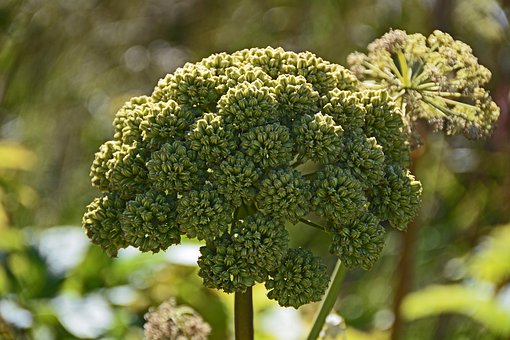No products in the cart.

The story of Angelica goes like this:
An Archangel revealed the medicinal plant to Marcus Sylaticus, a physician, way back in time... the 14th century.
And this is how it got its angelic name!
Join Gulzaar Foods, exploring the angelic world of bright green Angelica.

Appearance and Description
- In the first year only leaves grow, in the second year, there is a fluted stem that reached a height up to 2.5 meters.
- The perennial aromatic herb grows about 2 m tall.
- The thick bright green taproot hollow stems sometimes have a purple tinge.
- Cultivated sweet-scented edible roots and stems.
- Leaves have broad sheath bases divided into leaflets and are almost 70 cm long with leaflets.
- Leaflet edges are finely serrated and toothed. The leaves comprise of numerous leaflets divided into principal groups, which are subdivided into lesser groups.
- Flowers are globular umbels of 10- 14cm. The flowers blossom in the month of July.
- Each 4mm flower has numerous, small. greenish or yellowish petals and grouped into the umbels which bear oblong pale yellow fruits.
- Fruits are straw-colored, small and dry.
Angelica grows exclusively in the soil, that is damp, like rivers where there are huge water deposits.
Flavor
The root when dried is greyish brown and wrinkled externally. It is spongy and whitish inside with a starchy fracture, that exhibits shiny resinous spots.
The odor is fragrantly strong. The taste sweetish, a thereafter aromatic warm, bitterish and musky.
Uses
- The seeds and stems are used in confectionary, flavoring and preparing liqueurs.
- Once dried and placed in airtight containers, they retain medicinal qualities for years.
- Common commercial Angelica uses are candied stalks produced used for cake decoration. Candy art is a specialty in France as a confectionery trade.
- Raw angelica stems are eaten traditionally in Scandinavia The stalks can be eaten blanched like celery, and the leaves, candied or cooked, flowerheads are grilled or mixed eaten in omelets.
Angelica Health Benefits
It is related to Dong Quai, a respectable Chinese medicinal herb.
- It is a birthing herb used for delayed labor to expel the placenta for childbirth
- It relieves cramping and painful menstruation and is valuable to relieve delayed menstruation
- It contains compounds that block calcium and prescribed for heart health and high blood pressure
- It is a digestive aid to help calm digestive issues that are tension related.
- The root, leaf, and fruit, of Angelica, help to dispel gas, stimulate digestion, and calm a stomach.
- https://www.anniesremedy.com/bookshelf.php
- http://www.ipni.org and http://apps.kew.org/wcsp/
- http://www.botanical.com/botanical/mgmh/a/anegl037.html
Leave a comment






